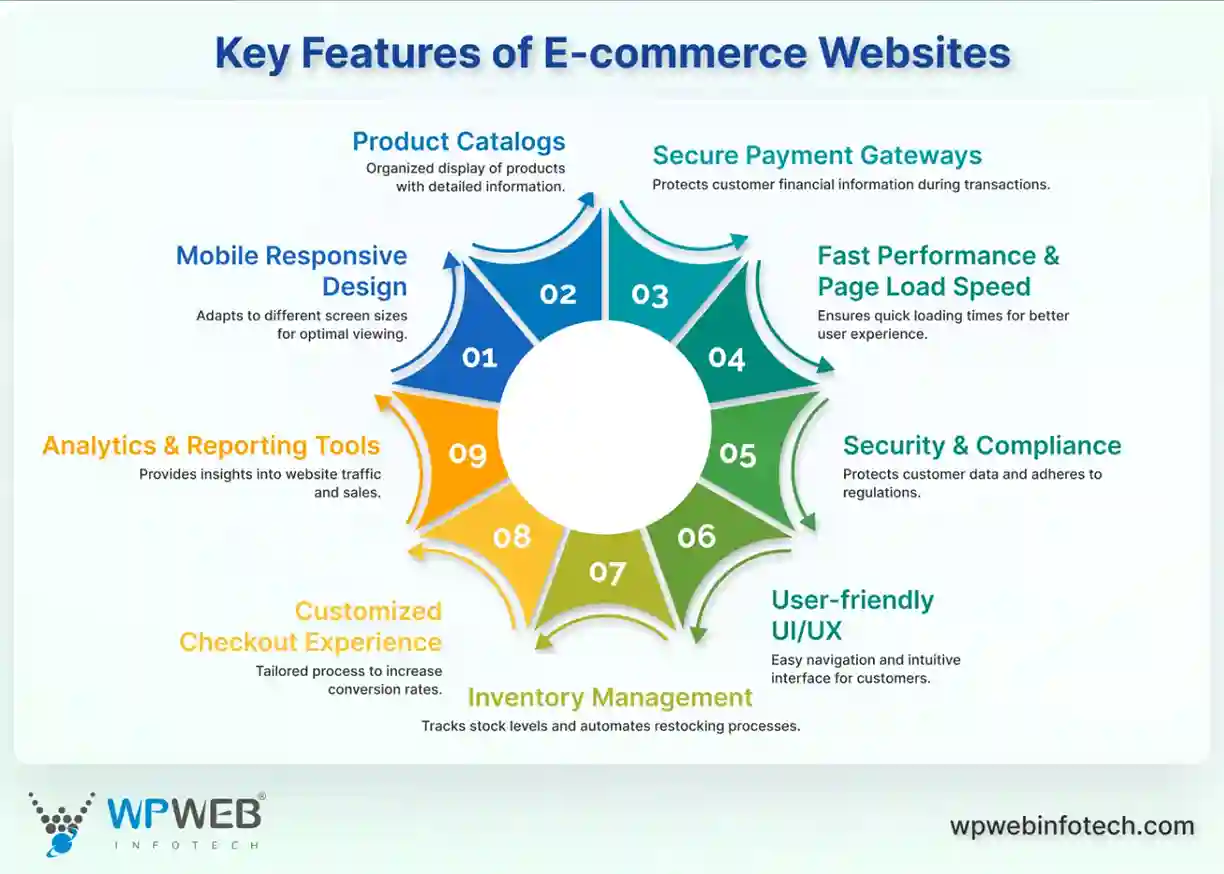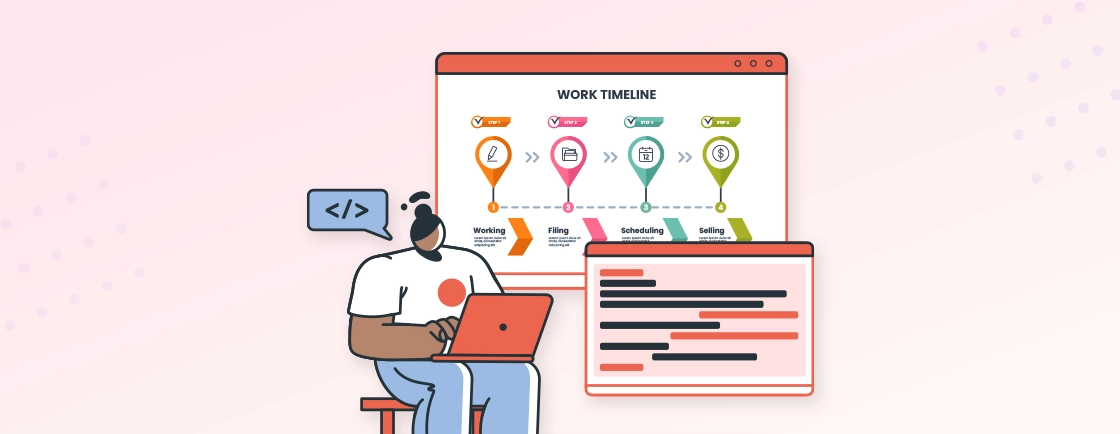Quick Summary
- E-commerce website development is a process for building secure, scalable, and customer-centric online stores.
- The process combines strategy, design, technology, and performance optimization to deliver seamless shopping experiences.
- Key features: mobile-responsive design, product management, payments, checkout, and security and performance.
- How to Create an E-commerce Website: Objectives, Domain, Platform, Design, Development, Fulfillment, Launch, and Maintenance
- Best Practices: Prioritize performance, build trust, secure payments, user-friendly interface, intuitive site structure.
- You can either use a CMS, create from scratch, or hire dedicated e-commerce developers.
Table of Contents
An e-commerce website isn’t just a page for selling your products and services online. With it, a customer can discover your brand online and purchase your product from anywhere, anytime.
Nowadays, building an e-commerce website is more than just starting an online store. You need to build a fast, secure, and data-driven experience that adapts to the customers’ preferences and advanced technologies.
Through this blog, we’ll explore e-commerce website development in detail, including key features, benefits, a checklist, and best practices. Let’s begin.
What is E-commerce Website Development?
E-commerce website development is the process of building an online storefront for selling products and services directly to consumers. On this website, you:
- Design and develop user-friendly and mobile-responsive UIs
- Integrate payment gateways
- Add and manage product catalogs
- Implement online shopping features
- Focus on security and support for the customers
An e-commerce website is used to showcase and sell products and services online. Its goal is to deliver outstanding shopping experience for the consumers while ensuring steady business growth. It means convenience for the shoppers and conversions and revenue for the business.
Benefits of Custom Ecommerce Website Development
Building an e-commerce website benefits both the business and its consumers. But you can take these benefits to a whole new level when the site is custom-built with a unique design and advanced features.
Let’s discuss the benefits for both businesses and consumers.
For the Business
- Unique Brand Experience: With custom e-commerce development, you are not limited to a particular theme or template. You can design the store to create a unique brand experience that sets it apart from competitors.
- Set the Best First Impression: First impressions are the last impressions. So when your store is custom-built, it shows you are trying something different. That sets a great first impression among new customers.
- Tailored for SEO Strategy: A custom e-store can be built with the SEO strategy in mind. That means considering factors like performance, coding efficiency, URLs and hyperlinks, and more. It will ensure your store ranks higher and gains more traffic. A proper eCommerce SEO strategy will be good.
- More Streamlined Operations: You can integrate CRM, ERP, and fulfillment systems and automate the workflows right from the get-go. That will improve the operational efficiency and reduce manual errors.
- Scalable Architecture: From the beginning, you can design and develop the store with scalability in focus. You can add new features and functionalities without any restrictive plugins.
For the Consumers
- Personalized Experiences: A custom e-commerce website can have AI-powered features to optimize and personalize the customer experiences. That means tailored product recommendations, dynamic pricing, and more.
- Intuitive Customer Journey: You can design the e-store focussing on easy product discovery and purchasing with few clicks and a simple navigation.
Building a custom ecommerce site takes it from a transactional functionality to a commercial asset. It fuels growth and cultivates lasting customer relationships.
Key Features of E-commerce Websites
Whether you create a custom e-commerce website or build on a specific platform, it should include key features. Let’s discuss these features one by one.

Mobile Responsive Design
A majority of users shop on their mobile phones. So the e-commerce website should be mobile responsive, adapting seamlessly across devices. It should offer consistent usability and faster navigation.
User-friendly UI/UX
A good user interface and experience includes intuitive navigation, clear product layouts, and easy-to-use search and filtering. That ensures frictionless customer journeys for a good experience. It reduces the bounce rates, so users can go from product discovery to checkout with minimal effort.
Product Catalogs
One of the key aspects of any e-commerce website is a structured product catalog. It should be properly organized with clear categories, product descriptions, images, and filters. So customers can find what they want within your website more easily.
Inventory Management
Along with the catalog, you need a streamlined inventory management system to track stock levels in real time. That way, you can prevent two bad possibilities: stockouts or overselling. With this system, you can even manage the products across multiple warehouses.
Secure Payment Gateways
After customers select their products and add them to the cart, they need a way to pay. That’s where a secure payment gateway comes in. It must use encryption and follow compliance standards. Also offer multiple options to satisfy every customer. It directly results in higher checkout rates.
Customized Checkout Experience
When a customer picks a product, they want to pay and check out quickly. You can simplify the steps by offering a customized checkout, guest checkout, flexible payment options, and varied shipping options.
Fast Performance & Page Load Speed
There are thousands of e-commerce websites worldwide. If your site is slow, customers may go to a competitor’s site. Your ecommerce website should load quickly and offer smooth browsing to improve search rankings and user satisfaction.
Analytics & Reporting Tools
Integrate analytics and reporting tools to get key insights of sales performance and customer behavior. It lets you optimize the site based on the conversion funnel.
Security & Compliance
You need strong security measures and regulatory compliance on your website. It helps protect customer data and transaction info and prevents data breaches. So the customers will have more trust in your website.
Together, these features improve your website’s operational efficiency and drive sustainable growth.
How to Develop an E-commerce Website?
Building an e-commerce website is a strategic process. It goes from planning (objectives and KPIs and platform selection) to technical execution (design and development).
Define the Objectives & Establish Your Brand
First and foremost, define what you want to achieve with your website:
- Sales numbers
- Target audience engagement
- Product focus
- Growth plans
You also need to define your brand identity, value proposition, and key performance indicators (KPIs). These will dictate how your design, functionality, and marketing will proceed.
Register a Domain Name
Next, choose and register a domain name according to your brand. It should be credible and easy to remember. A clean, niche-relevant domain name is more likely to rank higher in search results. Plus, it will give you long-term brand recognition.
Choose the Right E-commerce Platform
After selecting the domain name, you choose the right e-commerce development platform. It should be based on some key factors:
- Technical Requirements
- Easy to Use
- Development Budget
- Customizability
- Scalability and Flexibility
- Integration and Third-Party Apps
- Payment Processing and Fees
- Security and Compliance
- Customer Support and Resources
Some of the best e-commerce development platforms include Shopify, WooCommerce, BigCommerce, Magento, etc.
Work on the Design & Layout
Create a mobile-responsive e-commerce site design that focuses on navigation, usability, and visual consistency. Your website should include a clean layout, mobile-optimized design, and intuitive product menus. Customers should be able to browse the website easily and have a smooth checkout.
Plan Your Order Fulfillment Process
After creating a good site design, you need to plan your order fulfillment process. It will define how the orders will be processed, packed, shipped, and tracked. A clear order fulfillment means timely deliveries, accurate inventory updates, and a better post-purchase experience.
Code & Develop the Website Features & Functionalities
Now we come to the core part of this process: the site development. This phase involves integrating core features such as product pages, checkout, integrations, the cart, payments, and user accounts. During this phase, consider the performance, security, and scalability of your website.
Launch the E-commerce Website
After the design and development, you need to test the website’s speed, usability, security, and more. You can try launching it first in a staging environment to see how it performs. Also, a controlled launch for some beta users could be helpful. You can identify any potential issues and ensure a smooth customer experience from day one.
If everything goes well with the testing and staging, go ahead and launch the website.
Maintain the Website
Finally, the work doesn’t stop with the launch; you need to continuously monitor the website and optimize it for security, performance, and feature enhancements. That will keep your website competitive and aligned with the customer’s expectations.
If you want to build the best e-commerce website, professional help is always recommended. With us, you can get dedicated eCommerce development services.
Best Practices for E-commerce Website Development
Beyond just the development process, there are a few key practices to adopt. Adhering to them ensures your site is perfect for conversion, retention, and sustainable growth.
Prioritize Performance as a Key Feature
For a conversion-focused site like an e-commerce store, site speed directly impacts sales. So you need to optimize images, minimize code, and use a content delivery network (CDN) to improve load times.
A slow site increases cart abandonment, but a fast e-store will get higher search engine rankings.
Build Trust With Legal & Regulatory Compliance
As part of complete transparency, clearly display the policies for shipping, returns, and privacy. For that, you need to comply with regulations such as GDPR for handling customer and financial data. Compliance with all of this will build customer purchasing confidence and protect your business from legal risk.
Secure Payment Gateways & Data Security
Payment is key from a business perspective. So, integrate popular PCI-DSS-compliant payment gateways. Use SSL encryption throughout your e-commerce website. And to take it further, you need regular security audits and updates to protect customer data and maintain brand reputation.
Ensure a User-friendly Interface
Another key practice is to design the website for intuitive and user-friendly interaction. That means using clear CTAs, readable fonts, and setting everything within ample white space. A clean UI reduces shopping friction, enabling users to seamlessly move from browsing to purchase.
Keep the Website Structure Simple & Easy to Navigate
Implement a logical hierarchy with clear categories and powerful search functions. Customers should be able to find any product in just a few clicks. Simple navigation is crucial for a positive UX.
Popular Ways to Build an E-commerce Website
While the development process will remain the same, there are a few different ways to proceed. Each method balances ease of use, control, and cost suited to different businesses.
DIY (Through an E-commerce Website Builder like Shopify, BigCommerce, etc.)
First, you can try and Do-It-Yourself (DIY) using an all-in-one hosted platform like Shopify, Wix, or Squarespace. All you need to do is subscribe to a monthly plan and use their drag-and-drop site builders to create and manage the e-store.
Pros
- Speed to market
- Ease of use
- Managed infrastructure
- Predictable cost
Cons
- Limited customization (at least for beginners)
- Ongoing costs
- Platform dependency
- Scalability constraints
Use a CMS with Ecommerce Plugins (Like WordPress + WooCommerce)
This strategy combines a flexible Content Management System like WordPress with a powerful e-commerce plugin like WooCommerce. But you need to purchase separate web hosting and install the software to start building.
Pros
- High flexibility & control
- Strong content capabilities
- Cost-effective for scaling
- Data ownership
Cons
- Technical responsibility
- Complexity
- Greater initial setup
- Self-supported
Hire a Professional E-commerce Development Company or a Dedicated Developer
In this strategy, you hire either a professional ecommerce development company or a dedicated e-commerce developer (like a freelancer). They will take the responsibility for designing and developing the custom website.
Based on your requirements and budget, they will proceed with either an open-source platform like Magento or a fully custom-coded solution.
Pros
- Tailored solution & innovation
- Professional quality & scalability
- Strategic partnership
- Long-term asset
Cons
- High initial investment
- Longer timeline
- Ongoing relationship
- Vendor selection risk
For the beginners trying to build a medium or enterprise-level e-commerce website, the latter approach will be suitable. For that, you can hire eCommerce developers with us.
Let’s Conclude
Building a successful e-commerce website proceeds from a strategic foundation to technical execution and continuous evolution. There are three different ecommerce website development solutions to choose from: DIY approach, CMS approach, or professional hiring.
But you still need to prioritize the user, build for performance and trust, and let the extensive data guide your growth. It builds a platform beyond transactions; rather, it’s a strategic asset for customer-centric long-term success.
So, want help with your e-commerce development? Then connect with us today!
FAQs on E-commerce Websites
What are the different types of e-commerce websites?
Well, there are two main types of e-commerce websites: Vendor-specific websites and Multi-vendor marketplaces. On vendor-specific websites, one business sells just their own products and services. Multi-vendor marketplaces, on the other hand, are meant to feature and sell products and services from different sellers. Like, Amazon, eBay, Alibaba, etc.
Are there any ongoing costs for managing an e-commerce website?
Yes, there are ongoing costs like domain renewal fees, hosting prices, transaction fees, shipping and fulfillment costs, and marketing expenses.
How do I make my e-commerce website mobile-friendly?
To make your ecommerce website more mobile-responsive, make the design responsive, speed up the load times, simplify the navigation and checkout, and add features like click-to-call.
Build Your Ecommerce Store
Launch a high-performing ecommerce website with secure payments, scalability, and growth-ready design.





